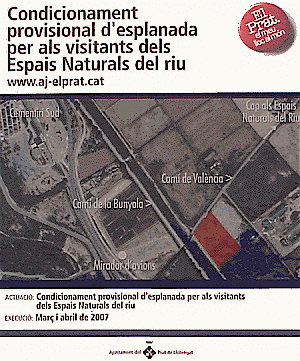River Llobregat Water Reclamation Project
|
A Visitors Centre has been opened in May 2007 that provides access to the new delta wetlands created by the River Llobregat water reclamation project.
The delta of the river Llobregat lies to the south of Barcelona and covers about 100 square kilometres. In spite of its very close proximity to the city, it constitutes one of the most valuable natural areas of the region. The wetlands are of international importance for wildlife and form a valuable wintering ground for many migratory species of birds. The delta aquifer is one of the most important fresh water resources of the Barcelona area, forming an underground source with a capacity of 100 million cubic metres of water. Numerous industries, agriculture and the population of the delta town of Prat de Llobregat use its water, extracting it through wells. The fertile delta farmland supports intensive agriculture to supply the local markets and as protected Green Belt land, helps restrict urban sprawl. Since the 1960s, the delta and associated traditional land uses such as market gardening have been under constant attack from Barcelona's urban and industrial expansion. Catalonia’s most important logistics and transportation infrastructures have become concentrated in the area: port, airport, motorway network and railways. Less than 5% of the original wetlands remain and in some municipalities half of the agricultural land has been lost in the last decade. By the end of the 1980s, the Llobregat was one of the most polluted and degraded rivers in Western Europe. Over-exploitation of the underground water had led to salinisation of the aquifer, with 30% now being unusable. The most recent city projects that affect the area are summarised in the Plan for the Llobregat Delta below. Future threats include the impact of rising sea levels.
Since 1991 and after the European directive on urban wastewater, a comprehensive programme of water treatment plants has been implemented along the river and the situation has improved dramatically. For example, the beach at Prat de Llobregat, near the mouth of the river, was a principal pollution black spot along the Catalan coast. It has been open now for bathing since 2002. The objective of the new water reclamation project is to maintain the
ecological flow of the Llobregat river which runs through Barcelona by partly
closing its access to the sea. The reclaimed water that was previously lost to
the sea is pumped upstream to increase the natural flow of the river as well as
to provide capacity for agricultural and golf irrigation and the recharge of
wetlands. The reclaimed water receives additional reverse
osmosis treatment for aquifer recharge to control
seawater incursion and salinisation. |
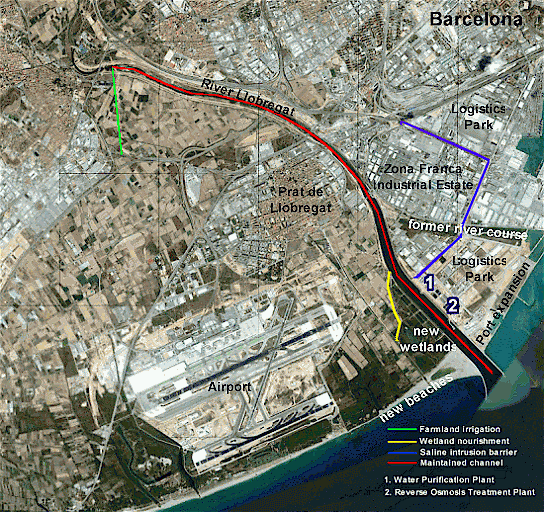 |
| River Llobregat water reclamation scheme |
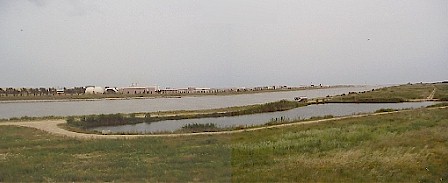 |
| New wetlands created at the river mouth |
 |
| A submerged breakwater at the river's mouth has helped create
a wide artificial channel |
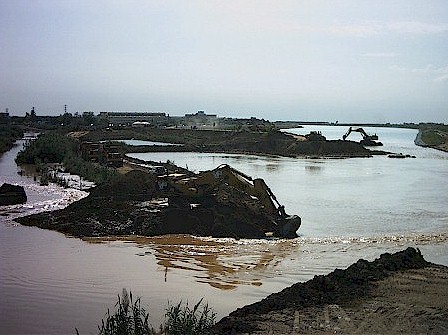 |
| Diversion of the river to create the new channel |
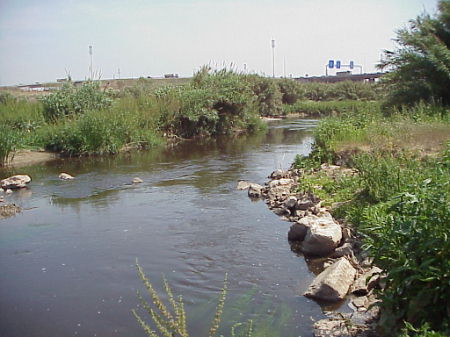 |
| River Llobregat immediately upstream of the managed channel |
Green Belt
A green belt is undeveloped or agricultural land surrounding an
urban area where development is heavily restricted by law. The purpose is to
protect natural environments and wildlife, improve air quality, ensure that
urban dwellers have access to countryside and protect the character of rural
communities which might otherwise be absorbed by expanding suburbs.
Barcelona's Green Belt
Logistics
Logistics is the management and control of the flow of goods and services from the source of production to the market. It involves knowledge, communication, transport and warehousing.
Reverse Osmosis
Reverse Osmosis involves forcing water through a porous semi-permeable membrane. The small pores of the membrane block salt and other natural minerals, which generally have larger molecules than water. These pores also block bacteria. Thus, reverse osmosis is very effective at desalinating water and providing mineral-free, clean water.
Salinisation of the Aquifer
An aquifer is an underground layer of permeable rock from which water can be extracted using a well. Water in an aquifer is called ground water. The Llobregat delta aquifer has a layer of fresh water near the surface and denser salt water under the fresh water. Salt water penetrates the aquifer by moving in from the sea. The thickness of fresh water on top of the salt water is normally about 40 metres of fresh water for every metre of salt water above sea level. Too much ground water in the delta has been pumped from wells for agriculture, domestic use and industry, leading to salt water intruding into the upper layers of the aquifer causing contamination of freshwater supplies.
Urban Sprawl
The unplanned and uncontrolled growth of urban areas into the
surrounding countryside.
Barcelona's
Urban Sprawl
Impact of rising sea levels on the Llobregat Delta

